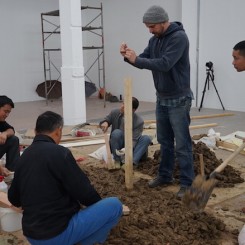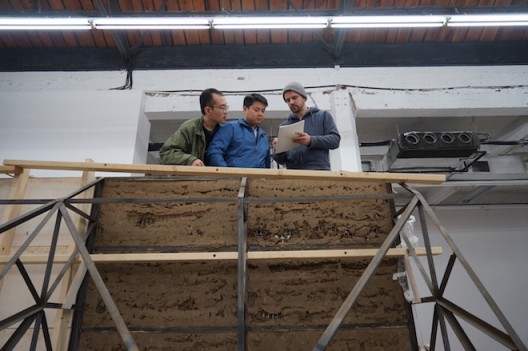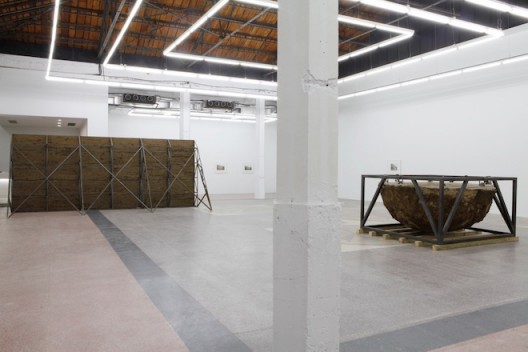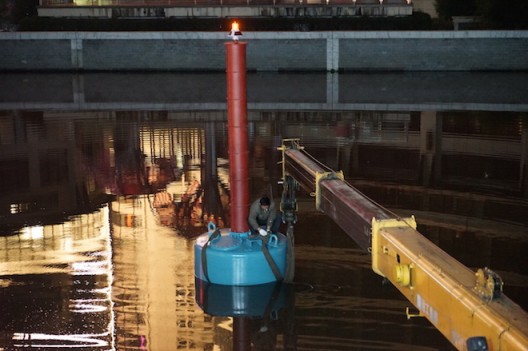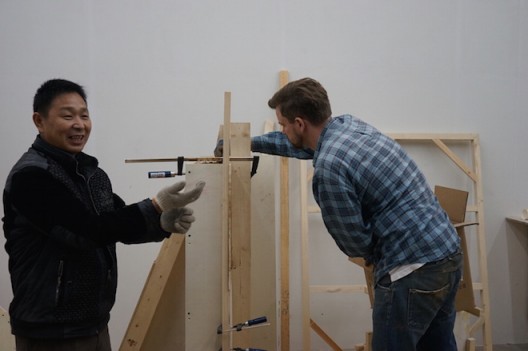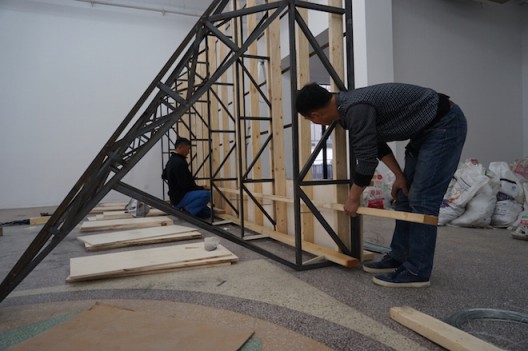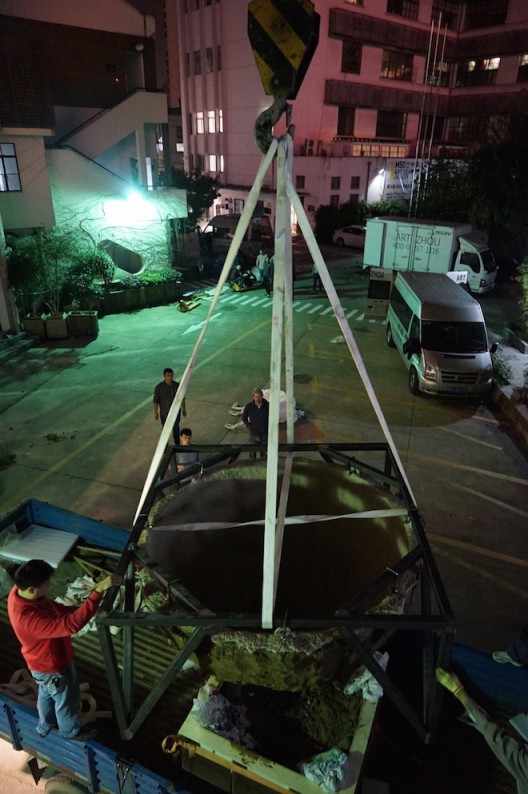I first met Karsten Födinger while we were penned up at the back of a small car being rushed from one museum opening—a recently opened museum, which of course was huge—to another in Pudong’s monumental waterfront spectacle of shiny high-rises. Karsten had just landed in China and he seemed over-stimulated. Up on the speedway, neon lights flew by our windows.
In a way, passing by construction sites in China is, one could say, like watching a real-time sculptural construction performance. I knew nothing about his works then, but his rugged appearance—baggy jeans, wide jacket, knit cap—struck me as someone who works with his hands, and it made sense when I later found out he deploys focused building materials: reinforced steel, wood, and concrete. Karsten Födinger’s large and materially rich sculptures elevated on simple, refined lines tend to be set up in a similar manner, blurring the distinction between art and engineering, sculpture and architecture.
One year after his first visit, he opened his first solo exhibition in China, at Antenna Space in Shanghai with “Critical Mass”, a discrete interplay of energy and balance responsive to the Three Gorges’ site potential forces and preventative structures, transposed into a rough, unutterable language through which he continues to drive both material and premises—the collapse load of the gallery—reminiscent of Richard Serra to the max. He further expands the exhibition to the public space, engaging with the surrounding context and the spectator’s perception; I feel lucky to have been able to follow his preparations, over the past few last months, on process-based works that are extensive and yet share an ephemeral quality as it often leads to dismantling after presentation.
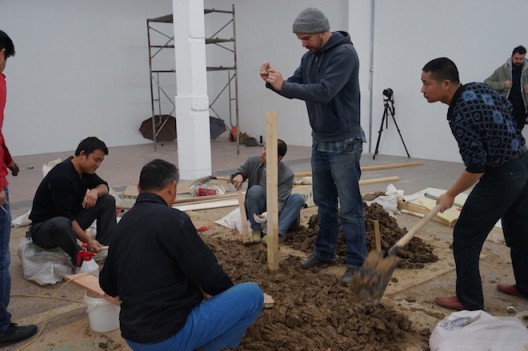
The artist and workers processing the mud and earth as materials for the work (photo: Nicoletta Jordanidis)
Nicoletta Jordanidis: This is your first time creating and exhibiting in China. How did you prepare for it?
Karsten Födinger: Exploring the space and its context is a basic element of my preparation, since I’m developing my works mostly out of the conditions of the space or place where they’ll be formed. When I visited Antenna Space in 2014, the gallery had a main hall and two smaller rooms, one of which afforded a view of Suzhou River. Back in Berlin, I did research on the Yangtze River, the Three Gorges Dam and Suzhou River. Then I developed a concept for the show with works that had to be produced during my two-month stay here in Shanghai.
NJ: How did you arrive at the idea of placing a buoy in the Suzhou River? And how did you realize it?
KF: The idea came from the desire to make the river part of the exhibition and extend the gallery space to the river site. I had already made some buoy/anchor-like pieces before, but they never touched water. The buoy here is carrying a metal framework for a round concrete column—a sort of starting point for a floating pile dwelling, an imaginary architecture: it’s about the contrast between perpetuity and volatility, an interplay that I see in the dam as well.
I thought that realizing it here in China would be much easier than in Germany, where putting an object in public waters is pretty much impossible due to strict regulations. But it turned out to be the same hassle here, or even worse. But the gallery assistants did a brilliant job of talking to the water authorities again and again, negotiating with different buoy companies . . . In the end, we got there.
NJ: The first work the visitor is confronted with shows a rammed earth wall which serves as a visual barrier to the gallery space. In previous exhibitions you have made a similar gesture of closure. Why hide the direct view of the space?
KF: This work, called “Fluvial Yingbi”, is referring to the “shadow walls” of classical Chinese architecture. So it’s a kind of protection for the space. At the same time it’s doing something similar to the movement of the visitor, as the dam does to Yangtze River.
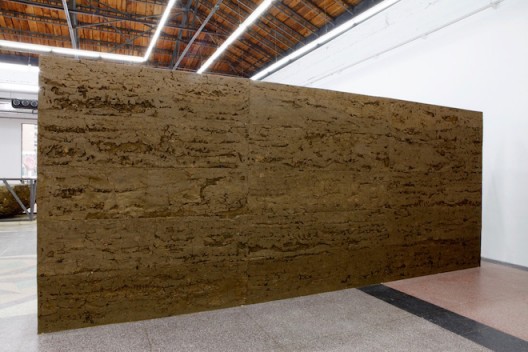
Karsten Födinger, “Fluvial Yingbi”, soil, steel, 600 cm (W) x 246 cm (H) x 203 cm (D), 2015 (photo courtesy: Antenna Space)
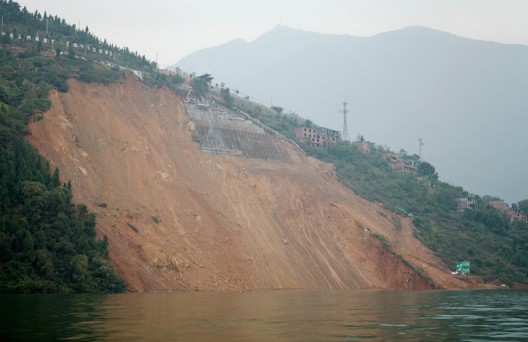
Karsten Födinger, “Critical Mass Photo Series”, giclee print on archival paper, 75.3 cm x 61.7 cm (each / framed), 2015 (photo courtesy: Antenna Space)
NJ: You talk of protection; there is an awareness of the potential of “natural” catastrophes—avalanches, earthquakes, floods—accompanying your work. In “Critical Mass”, you make direct reference to landslides in the Three Gorges area; even a drowned world could be imagined in the space at some point…
KF: These “natural” catastrophes as you call them are very basic and radical threats to human life and our societies. A lot of them are less natural than man-made, such as avalanches, floods, or landslides: where do these sensitive systems come from and how does civilization establish itself in these environments? The basic fascination for me involved how potential forces and their directions are visualized in preventative structures that are built. Societies are reflected in these measures. It’s like site-specific memento mori. Furthermore, these radical threats match my approach to a sculptural reduction, making the work as radical as possible. Ultimately I stumbled into this topic by doing research following my first impulse—the dam. So I’m actually totally innocent. (Laughs).
NJ: Are you thinking in terms of the Anthropocene with the issues related to the Three Gorges?
KF: This dam is a structural reaction on certain circumstances and needs of human society—such as the threat of human life by floods or the increasing demand for electrical power supply. It arises from a mentality that follows the belief that nature should be subject to human control.
My art is a reaction on the world I’m living in and part of it is an environment that is heavily influenced by humanity all over the globe. To me the discourse of Anthropocene is relevant, but I´m no geologist. Whether you put a label on it or not, the influence is evident. I don’t want to exploit art for any political statements; It’s just a reaction on realities I’m confronted with. I’m more interested in asking questions than giving comments.
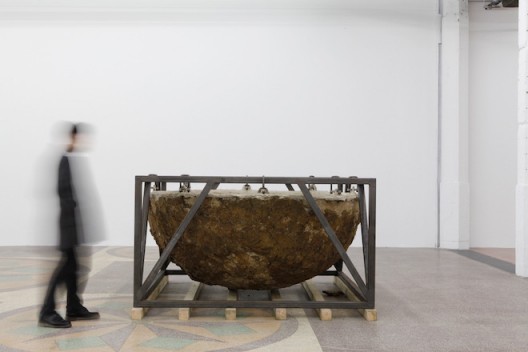
Karsten Födinger, “Critical Mass (Inertia’s Basin)”, concrete, steel, sleeper, 220 cm (W) x 220cm (D) x 130 cm (H), 2015 (photo courtesy: Antenna Space)
NJ: The concrete shell “Critical Mass (Inertia’s Basin)” is central to the exhibition. Can you explain the process of making it?
KF: It was quite a job that we could only finish with the support of Bonddex, a concrete company based in Wujiang with lots of experience in shotcrete application. Shotcrete is used to stabilize slopes, such as the riverbanks of the Three Gorges. That was one reason why I wanted to work with this technique.
The basic idea was to dig a hole and use it as mold for a basin-like concrete cast. It was a very immediate physical, sculptural work that took Zian [the gallery assistant] and me about two days. The most difficult thing was to get the perfect hemisphere. At the same time, a metal reinforcement basket was prepared to stabilize the concrete afterwards. After we finished the excavation, we started the shotcrete application inside the hole.
The concrete had to harden for about a week. Then we dug a larger hole around the concrete form to excavate it, so we could lift it with a crane and transport it to the gallery. Since the total weight of about 800 kg would have exceeded the load capacity of 200kg/m2 of the gallery floor, I developed this metal frame rimmed with lumber to spread the weight across about 4.5 squared meters. Downstairs in front of the gallery we mounted the basin in its frame and lifted the whole piece with a crane to the level of the gallery and moved it with two pallet jacks and a lot of manpower into the space.
NJ: The dimensions of your works often require extensive collaboration. Here in China, it was a large team of workers. Was there something you found particularly interesting regarding craftsmanship or ways of processing compared to what you knew before?
KF: I wanted to be able to communicate with the workers, so I started learning Chinese in February 2015. As you might guess I only made it to a survival level. That made collaboration more difficult. But I enjoyed it a lot. I had a small studio space that belongs to a carpentry that is doing a lot of art productions and exhibition set-ups. I could use all their tools and machines. At midday they took me with them to the boss´s house and we had lunch together. That was the best. I was part of a team, having lunch in an apartment somewhere in Shanghai. And I learned a lot about the Chinese culture of labor and about Chinese improvisation. For compacting the mud wall, for example, the workers built a bunch of self-made tools, which are super beautiful—so beautiful that I decided to make them an edition. In Germany people are more used to buying certain tools for certain problems. Here it seems like you built your own or you solve it with manpower. But it was also surprising to me that it seems like nobody wants to take responsibility. If I ask a professional in Germany to solve a technical problem, I can rely on him to take care of it. Here it turned out that I mostly had to figure out how to solve that problem. I definitely had to get used to that.
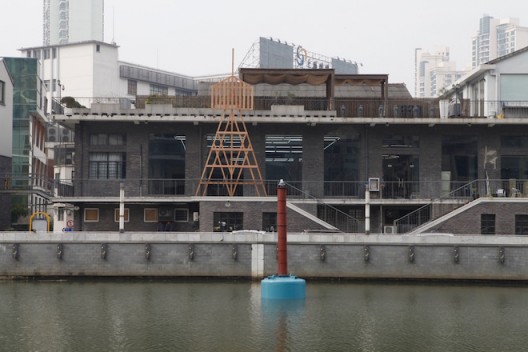
Karsten Födinger, “Lureleï / Pile Dwelling for Lureleï”, Lureleï: wooden beam, 440 cm(W) x 220 cm(D) x 900 cm(H); Pile Dwelling for Lureleï: steel, found object (buoy), 180 cm(W) x 180 cm(D) x 647 cm(H), 2015 (photo courtesy: Antenna Space)
NJ: There is a consistent engagement with structural and material instability in your work. How do you view instability in relation to this exhibition?
KF: It’s the thread running through all the works—even in the communication between “Lureleï” and “Pile Dwelling for Lureleï”, and of course in the setup of the buoy itself.
NJ: “Lureleï” and “Pile Dwelling for Lureleï” refers to the wooden beacon structure behind the gallery and the buoy in the river that it is facing. Both built a strong contrast with the urban surroundings of the Suzhou Creek. Simultaneously, the titles echo a myth-shrouded rock situated at the bank of River Rhine, the Lureleï, which then holds a strong resemblance to the rocks along the Yangtze that you depicted in the “Critical Mass” photo series shown inside the gallery. This is an example of how different places overlap in the exhibition. How do you think of abstraction as part of your work?
KF: On one hand, I would say I use abstraction more in the sense of displacement—altering the context by isolating and shifting it. On the other hand, it’s part of the sculptural process. I always try to reduce—to cut superfluous aspects. If you want, you can compare this to subtractive methods such as carving wood or chiseling stone.
NJ: It so happened that some people thought of your work as installation here. Others like to see in the reduced architectural elements a radical form of architecture. However, you define yourself as a sculptor. Could you comment on the positioning of your work, and what you think distinguishes it as sculpture?
KF: You can call it installation if it helps you categorize it. I’ve the feeling that here in China the concept of sculpture is more traditional. But I’m not a big fan of the label “installation”. For example here, in “Critical Mass”, in the end it’s all autonomous pieces that compose the bigger picture. So, yes, I call them sculptures. One work emphasizes sculptural practice in general. “Critical Mass (Inertia’s Basin)” is a sculptural work through and through.
The larger scale works I did in the past which involve the whole space are also sculptures to me. There is actually a good deal of overlap with architecture in my work, but I’m an artist, not an architect. Sculpture and architecture exist under the same preconditions, and there are several intersections in terms of their problems. But at the end of the day I leave it to the spectator. To me, the relationship between sculpture and motion, time and forces is a big motivation for my practice.
NJ: The physical act of making or the realization of the idea plays an important role in your way of working, which results in a certain dimension of the work. Could one say that you are interested in exploring the liminal experience of the work?
KF: Yes. I need that.



